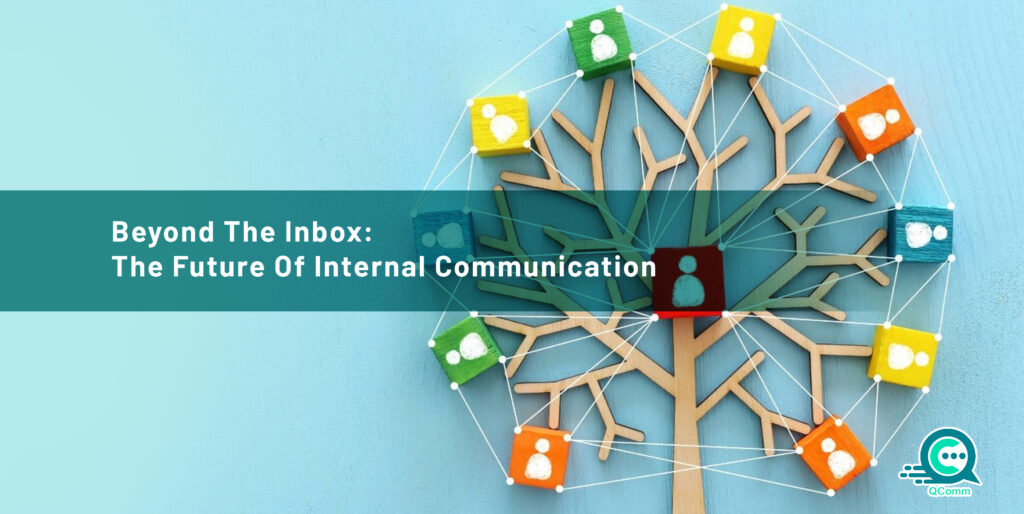
Did you know that a whopping 74% of employees feel they’re missing out on important company news?
This disconnect often stems from outdated internal communication strategies that rely heavily on email. While email has served its purpose for decades, the modern workplace demands a more engaging and efficient approach.
But, what is that approach?
Worry not, here we’ll explore the limitations of email for internal communication and dive into the exciting future of this critical aspect of any organization. That’s not it, this guide will discuss the rise of internal communication tools and how they can empower your employees, boost collaboration, and ultimately, drive business success.
Downside Of The Inbox Overflow
Email has undoubtedly revolutionized communication, but in the context of internal communication, it can be a double-edged sword. Here’s why:
Information Overloaded
Employees are bombarded with emails daily, leading to information overload and difficulty finding important updates. A study by McKinsey & Company found that knowledge workers spend an average of 28% of their workweek reading and responding to emails. This can significantly impact productivity and focus.
Lack Of Engagement
Emails are often one-way communication channels. They lack the interactivity and real-time engagement needed to foster a connected workforce. Employees may not feel compelled to participate actively in discussions or ask clarifying questions through email.
Security Concerns
Sensitive company information sent via email can be vulnerable to breaches or accidental leaks. Traditional email systems may not offer robust security features to safeguard confidential data.
Search & Organization Challenges
Finding specific information within long email threads can be a time-consuming nightmare. The lack of proper tagging, categorization, or search functionality makes crucial information difficult to access later.
Version Control Issues
With multiple email threads on the same topic, it can be confusing to track the latest version of information. This can lead to miscommunication and wasted time spent clarifying outdated details.
Age Of Internal Communication Tools
Fortunately, the future of internal communication is bright thanks to the emergence of innovative internal communication tools. These platforms offer a multitude of features designed to overcome the limitations of traditional email. Here’s how:
Centralized Hub
Internal communication tools become a one-stop shop for all company updates, announcements, and resources. This eliminates the need for employees to sift through cluttered inboxes, making information easily accessible.
Targeted Communication
Internal communication tools allow for targeted communication based on department, team, or role. This ensures that employees receive the most relevant information and reduces information overload.
Interactive Features
Many platforms offer features like forums, polls, and chat functionalities. This fosters a more interactive environment where employees can engage in discussions, ask questions, and provide feedback in real time.
Enhanced Security
Many internal communication tools prioritize data security by offering features like access controls, encryption, and data loss prevention measures.
Improved Search & Organization
Internal communication tools offer robust search functionalities and the ability to tag and categorize information. This allows employees to easily find what they need, saving valuable time.
Real-Time Example: Think of a situation – a marketing team brainstorming a new campaign on an internal communication platform. They can utilize chat functionality to discuss ideas in real-time, upload images and videos for collaborative review, and even conduct polls to gauge employee sentiment. This fosters a dynamic and interactive environment for effective communication. |
Statistical Form Of Showcasing The Impact Of Internal Communication
The benefits of effective internal communication are undeniable. Studies have shown that:
- Organizations with a strong internal communication strategy experience 20-25% higher productivity (McKinsey & Company).
- Employees who feel informed and connected are 85% more likely to be motivated (Gallup).
- Companies with highly engaged employees are 21% more profitable (Kenexa High-Performance Institute).
Real-Time Example: Take a company struggling with low employee morale and declining productivity. Implementing an internal communication tool can create a more transparent and engaging work environment. Employees feel more informed and connected, leading to improved collaboration, increased motivation, and ultimately, a boost in productivity and profitability. |
Picking The Right Internal Communication Tool
With a plethora of internal communication tools available, it’s crucial to choose the one best suited to your organization’s needs. Here are some key factors to consider:
Company Size & Structure
Large enterprises may require a more robust platform with advanced features, while smaller businesses may benefit from a more user-friendly and cost-effective solution.
Ease Of Use
A user-friendly interface is crucial for widespread adoption. Look for tools that require minimal training and offer intuitive navigation.
Employee Needs
Identify the needs of your workforce. Do they require real-time messaging functionalities, or is a centralized repository for company documents more important?
Integration Capabilities
Consider how the tool integrates with other systems your organization uses, such as HR, project management, or customer relationship management (CRM) platforms.
Budget
Internal communication tools come with varying costs. Determine your budget and identify features that offer the most value for your investment.
Analytics & Reporting
Data-driven insights are essential for measuring the effectiveness of your internal communication efforts. Look for tools that provide analytics and reporting capabilities.
Mobile Accessibility
With employees increasingly working remotely or on the go, ensure the tool offers a mobile-friendly experience.
Overcoming Challenges And Measuring Success
Implementing a new internal communication tool can present challenges. Here are some tips to ensure a smooth transition and measure success:
Change Management
Communicate the benefits of the new tool clearly and address employee concerns. Provide adequate training and support during the transition.
Data-Driven Approach
Track key metrics such as user engagement, message reach, and employee satisfaction. Use this data to refine your communication strategy and demonstrate the tool’s impact.
Employee Adoption
Encourage tool usage through gamification, contests, or incentives. Celebrate early success stories to inspire others.
Continuous Improvement
Regularly gather feedback from employees to identify areas for improvement. Stay updated on the latest internal communication trends and tools to ensure your organization remains at the forefront.
By tracking user engagement metrics and employee satisfaction surveys, a company can identify which content and communication channels resonate most with its audience. This data-driven approach allows for continuous improvement and optimization of the internal communication strategy. |
Future Of Internal Communication
The future of internal communication is bright and full of possibilities. Emerging technologies like artificial intelligence (AI), augmented reality (AR), and virtual reality (VR) are poised to transform the way organizations connect with their employees.
AI-Powered Chatbots
AI-powered chatbots can provide instant answers to employee queries, freeing up HR and IT departments to focus on more strategic tasks.
Augmented Reality for Training
AR can be used to create immersive training experiences, enhancing knowledge retention and skill development.
Virtual Reality for Remote Collaboration
VR can facilitate virtual meetings and collaborative projects, fostering a sense of connection among remote teams.
While these technologies are still in their early stages, they hold immense potential to revolutionize internal communication and create a more engaging and productive workplace.
Final Words
Email is no longer sufficient for meeting the demands of today’s dynamic and interconnected workplace. Internal communication tools offer a powerful solution for enhancing employee engagement, collaboration, and productivity.
By embracing the future of internal communication and leveraging the right tools, organizations can build a strong foundation for success.
Remember, effective internal communication is not just about sharing information; it’s about fostering a culture of connection, collaboration, and employee empowerment.


